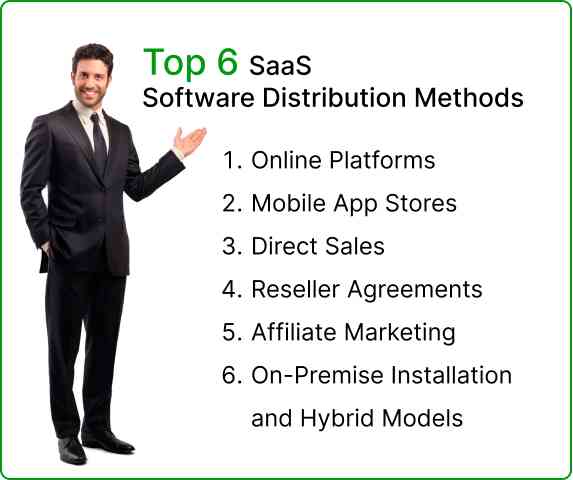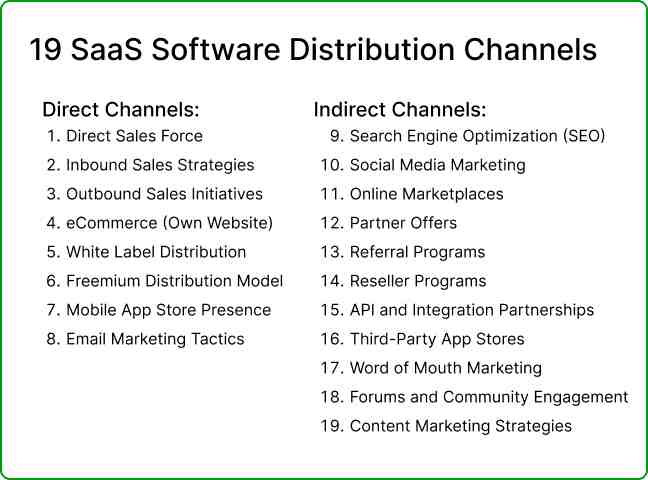 SAAS
SAAS

31 December, 2023

How is SaaS software distributed? Struggling to know the answer to this question? Many people do so. So, SaaS software is distributed through direct sales on the vendor’s website or indirectly through third-party resellers. SaaS, or Software as a Service, is changing how businesses use software.
A good distribution strategy ensures that software reaches the right audience, grows our customer base, and improves revenue. It is like using apps online instead of downloading them.
Want to know more about the methods of distributing SaaS software? Then this blog is for you. Here, I will share the definition of Saas distribution, its 19 channels, methods, benefits, and many more.
Tech lover or just want software to be simple? Stay tuned to learn the answer to ‘How is SaaS software distributed?’ So, let’s start the discussion with SaaS software distribution.
Contents
Before knowing the answer to ‘how is SaaS software distributed?’ you must know what is SaaS distribution.
SaaS distribution is the whole process of getting cloud-based software to you. It includes the ads, the sales, and the smooth handoff. It is like the behind-the-scenes magic that makes sure you can easily find, get, and enjoy your apps without any issues,
In SaaS Distribution, there are two ways. One is direct and the other is indirect. Direct is like buying straight from the app’s website. Indirect is when the app joins forces with sellers who pass it on to you.
So, SaaS distribution is a procedure that takes software from the creators and puts it right at your fingertips. It ensures that you and the software connect smoothly.
SaaS distribution channels are like how you sell software to your target audience. It is about who sells it (like sales teams or online stores) and how. First, the owner decides how to sell the software through the platform.
It impacts how the company makes money, hires, and sets prices. Startups usually begin with one way and might try more as they grow. Large enterprises mostly take the help of third parties to sell their software.
So, using different methods to sell software to users is known as SaaS software distribution channels.
A recent study shows that the most popular SaaS distribution channels are direct sales, app stores, and reseller channels. (Source: SaasCEO)
We can divide the SaaS software distribution channel into 2 broad categories. One is the direct channel and the other is the indirect channel.
Let’s learn about direct and indirect channels here.
Direct SaaS distribution is like selling straight to customers without third parties or middlemen. It is a direct connection between the company and users, making it clear and straightforward.
Indirect SaaS distribution uses other channels, like app stores and resellers. It is a smart strategy for startups to grow by reaching more people through different sales avenues.

Distributing SaaS (Software as a Service) to users involves various methods. These methods depend on the different preferences of customers and businesses.
Let’s learn about the top 6 SaaS software distribution methods and tips about the methods that you should know here:
Online platforms make the distribution easy for you to get SaaS quickly. It is known as the most stress-free method ever! Just go to the provider’s website use marketplaces, and subscribe to the service. Simple!
Tips:
When SaaS is on mobile app stores, you can easily access it. You can use software features right from your handheld device. It has become very convenient and easy!
Tips:
With direct sales, SaaS providers connect with you directly. They use subscription plans, smart marketing, and great support to ensure you have the best user experience and stay satisfied.
A recent study shows that 35% of SaaS companies partner with professional services firms, often acting as resellers. (Source: DevSquad)
Tips:
In reseller agreements, SaaS providers team up with businesses. They offer custom solutions, reach many different customers, and make everyone happy.
Tips:
By sharing referral links, you can earn money through commission-based sales. It is a great way to grow your customer base and boost your revenue. A smart move is to partner with the affiliate.
Tips:
Some SaaS apps let you install on your servers. They adapt to your existing systems for a customized experience.
Tips:

There are two board categories of distribution channels for SaaS software. But, these two categories have many subcategories. Experts suggest that there are a total of 19 SaaS software distribution channels.
Here, I will explain these 19 SaaS software distribution channels under two broad categories which will also answer your question How is SaaS software distributed?
So, let’s begin the discussion:
For direct channels, we have 8 subcategories that you should know. If you want to distribute your SaaS software through direct channels, use any of these 8 channels.
Let’s explore these 8 direct channels together:
Direct sales is known as the traditional way. Here, a dedicated sales team proactively reaches out to potential customers for better customer experience.
This method is effective but requires a substantial investment in a skilled sales team. It also needs a proper sales strategy to get the expected outcome.
Inbound sales focus on attracting and converting leads into customers. It applies different latest techniques to generate the leads. Through content creation, optimized landing pages, and other tactics, the goal is to engage the target audience on the company’s website.
Gradually, through this method, the main aim is to convert them into customers. This method is particularly beneficial for SaaS companies with a strong online presence. Using inbound sales strategies you can achieve your customer engagement goals.
Outbound sales involve reaching out to people who have yet to express prior interest. This approach aims to increase brand awareness, generate new leads, and boost revenue through proactive communication.
eCommerce is a direct distribution channel for software distribution. Here, SaaS companies sell their products directly through their website. They provide enough information about the product, mention the pricing and delivery process, etc on the website.
A well-designed online store with a clear pricing structure can increase revenue, and generate leads. It also helps to enhance customer loyalty. Different levels of customer engagement are possible with own website.
White-label distribution means selling software without a brand to agencies or resellers. They can then put their brand on it and sell it. This helps SaaS companies reach more people, make more money, and provide customized solutions to customers.
Freemium models provide a free basic version of the software and charge for extra features. This way, it brings in users, creates leads, and opens up the chance to sell the premium version.
Sharing your SaaS products on places like AppSumo or DealMirror helps more people see them around the world. For global recognition, this is the best way that you can choose. But to do well in these busy places, your software needs to be good and match what people are looking for.
Email marketing lets SaaS companies talk directly to possible customers, share updates, and offer special deals. Having a strong email list with potential customers is important for good communication.
The other broad category of distribution channel is the indirect channel. Here, I will discuss the rest of the 11 subcategories channels under it. You can any of these channels if you prefer to sell and distribute your software indirectly.
Let’s learn about these 11 indirect channels together:
The target audience can easily find your software on the internet with the help of SEO. By optimizing your website and content for search engines, you can reach more people. They will know about your software. It brings more visitors to your website and brings in potential customers.
People nowadays use too much social media. Using social media is like telling more people about your software.
It helps more people know our name, visit your website, and become potential customers. You need to know who you are talking to with a proper plan. This helps a lot to sell your software.
Online marketplaces are like big malls for software. When you put your product there, more people see it and compare it with others. It is the easiest way for you to get noticed by a whole new bunch of customers.
Working with other businesses to share your software with more people is like teaming up with friends.
When you partner with companies that match well with you, it helps you to reach more people and find new potential customers. It expands your group and meets new faces.
Referral programs encourage your current customers to recommend your product to others. When these programs are well-organized, they can make more people aware of your brand. They also help you to bring in new leads, and build loyalty by offering rewards and making the referral process easy.
Reseller programs mean you join teams with sellers to reach new customers. By tapping into their existing customer base, you can expand your reach and sell more. It helps to grow your sales.
Teaming up with other businesses to make your products work with their systems is a way to reach more people. These partnerships help you to find new customers because your stuff fits right into what they are already using
Keeping your products in app stores lets more people see them. But to do well in these busy places, you need a product that’s well-designed and matches what people want.
Getting your existing customers to tell others about your product is like using word of mouth. To make this work better, you need to build strong relationships with your customers. You must give good customer service, and offer rewards for referrals.
Talking to potential customers in online groups through forums and freebies is like reaching them indirectly. Being part of these active communities and giving useful stuff can make more people know about your brand and become potential customers.
Content marketing is about producing really good content. Using the content to get noticed and find new customers. When you show you know your content, people start trusting you more.
After getting the answer to ‘How is SaaS software distributed?’, you should know the benefits of the distribution. The way software reaches users is an amazing process.
Let’s break down the benefits of distributing SaaS software here:
SaaS distribution channels break local barriers. It puts software providers on the map globally. This means more customers and more money as businesses connect with diverse users far and wide.
Well-run distribution networks increase profiles and sales. By using these channels smartly, SaaS companies make more money and keep the profits rolling in.
A famous quote is, ‘Teamwork makes the dream work’. It works the most when it comes to the inventory costs. Distribution channels share the load that brings down overall costs for manufacturers.
No one can predict the future of a business as it is always at risk. So, for businesses, distribution channels are like safety nets.
From unpredictable demand to pricing challenges, these channels spread the risks around. These channels protect manufacturers from potential risks and losses within the industry.
Distribution channels are not just delivery people. These are also the eyes and ears of the market. They gather feedback and data. It helps the producers to understand what customers want, what is trending, and what the competition is up to. These channels prepare the software producers for the next move.
SaaS distribution channels let companies stick to what they are good at. They help companies to innovate and make new products.
While channel partners handle the essentials of getting the software to users, businesses can keep working on new ideas and better products. This is the huge plus point of SaaS software distribution.
Some distribution networks go above and beyond. They offer extra services like installation, repairs, and top-notch customer care. When customers are happy, they will purchase more products from you in the future.
Answer: Yes, usually, SaaS works with subscriptions. Here, you pay regularly for online access, updates, and support. Some also offer pay-as-you-go, letting you pay for what you use without a fixed subscription.
Answer: SaaS is user-friendly. All you have to do is just sign up, and pick a plan. There is no need for any extra staff needed for setup or updates.
It connects with other apps, customizable dashboards, and automatic upgrades. Flexible pricing from trial to fit your business needs. So, it is Simple, affordable, and makes your business run smoothly.
Answer: SaaS, or Software as a Service, means the software you use online through a subscription.
B2B is when businesses sell to other businesses, building relationships. B2C is selling directly to individuals, focusing on a good customer experience. Sometimes, a SaaS company can sell to both businesses and individuals, and B2B businesses might use SaaS to work better.
Answer: Businesses use SaaS for keeping track of customers (CRM) and Enterprise managing resources (ERP). It helps with virtual meetings, team chats, and getting insights from data. You can also use it for managing projects, communication, marketing, online stores, and even education.
Answer: Comparing SaaS and on-premise costs involves upfront expenses for on-premise and subscription fees for SaaS.
On-premises costs a lot upfront for hardware and licenses. While SaaS has subscription fees for software access and updates. Although on-premises seems cheaper initially, SaaS is more cost-effective in the long run despite putting in subscription fees.
Finally, I believe now you know How is SaaS software distributed? Distribution is the key to reaching users far and wide for SaaS software. Companies use SaaS software distribution channels to sell their products.
We can divide SaaS software distribution channels into two broad categories: Direct and Indirect Channels. These two board categories also have many subcategories. I have already discussed them in this blog. Go through them and select any of the channels to sell your SaaS software.
Direct channels, like direct sales and eCommerce, offer a straightforward connection, while indirect channels, including SEO and social media, tap into wider audiences. The benefits of using these channels are clear such as global reach, increased profits, and the ability to focus on innovation.So, next time you wonder, How is SaaS software distributed? remember, using different methods and channels companies distribute the software to their customers. So, try them today, sell your SaaS software, and bring success to your company